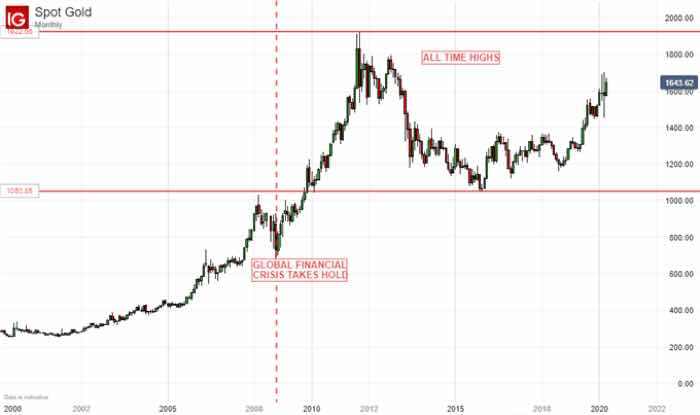
2020-04-13 17:22
Market analysisGold Prices May Stay High as 2008 Crisis
Related product:
Others,Commodity,Others,Others,Others,Others
Market analysis:
GOLD PRICES, INTEREST RATES, 2008 FINANCIAL CRISIS, COVID-19 – TALKING POINTS:
The coronavirus broke upon a world where monetary policy was already extremely loose
Fiscal authorities sensing danger have stepped in with a will
But this remains uncharted monetary territory
In coronavirus the global economy has been hamstrung by a crisis which, in monetary terms, had not really recovered from the previous one.
The 2008 global financial crisis (GFC) wreckage is still clearly visible across the world in the often record low interest rates which were already in place before the virus struck. Moral hazard is never far away from financial markets who can now see the cost of keeping rates low to fight the last crisis: there’s too little ammunition left to fight the next one.
In more usual times the authorities have room to make swingeing cuts to borrowing costs in an effort to stimulate their economies. The GFC saw US rates come down from more than 5% to effectively zero, having risen back to that point from around 2% in 2004. The global economy sailed in to the coronavirus with the upper bound of the Fed Funds target rate range at a princely 1.75%, already very low by historical standards.
And the Fed has at least managed to raise interest rates from their financial crisis lows. They remained negative in Japan, and at record lows almost everywhere else, even as the virus struck.
Accorded almost magic properties in the days of Alan Greenspan, the effectiveness of conventional monetary policy had come to be doubted even by those who practice it, in the months before coronavirus hit.
'NORMAL’ INTEREST RATE LEVELS HAD ALREADY COLLAPSED
Interest rate suppression had become a necessity in order to stop businesses and households who’d been incentivized by low rates to borrow to the hilt from going under. Sure enough they were delivered, but they left very little room for crisis fighting. As we now see. Happily the world’s fiscal authorities have seen this problem for what it is, and stepped into the monetary policy gap with huge stimulus programs of their own, most notably the US’ two-trillion-dollar whopper.
But this too comes with considerable hazard, especially if the coronavirus forces the global economy into deep freeze for a prolonged periods. National balance sheets were already groaning, the costs of economic rescue will inevitably put strained credit ratings under further duress.
What this means for trading markets is likely very simple. The bid for so-called haven assets is likely to be stronger than it was, and probably far more lasting. Think gold, the Swiss Franc, the US Dollar and the bonds of ever-rarer, rock-solid national borrowers. Riskier plays, by contrast, may well see more skittish demand profiles.
To some extent we are merely seeing a trend long in place turbocharged by the coronavirus.
Gold prices for example have been permanently at levels which would be regarded as historically quite high ever since the end of the financial crisis in 2009.

TPKNX
Participants
Hot content
Industry
Event-A comment a day,Keep rewards worthy up to$27
Industry
Nigeria Event Giveaway-Win₦5000 Mobilephone Credit
Industry
Nigeria Event Giveaway-Win ₦2500 MobilePhoneCredit
Industry
South Africa Event-Come&Win 240ZAR Phone Credit
Industry
Nigeria Event-Discuss Forex&Win2500NGN PhoneCredit
Industry
[Nigeria Event]Discuss&win 2500 Naira Phone Credit
Forum category

Platform

Exhibition

Agent

Recruitment

EA

Industry

Market

Index
Gold Prices May Stay High as 2008 Crisis
 United States | 2020-04-13 17:22
United States | 2020-04-13 17:22GOLD PRICES, INTEREST RATES, 2008 FINANCIAL CRISIS, COVID-19 – TALKING POINTS:
The coronavirus broke upon a world where monetary policy was already extremely loose
Fiscal authorities sensing danger have stepped in with a will
But this remains uncharted monetary territory
In coronavirus the global economy has been hamstrung by a crisis which, in monetary terms, had not really recovered from the previous one.
The 2008 global financial crisis (GFC) wreckage is still clearly visible across the world in the often record low interest rates which were already in place before the virus struck. Moral hazard is never far away from financial markets who can now see the cost of keeping rates low to fight the last crisis: there’s too little ammunition left to fight the next one.
In more usual times the authorities have room to make swingeing cuts to borrowing costs in an effort to stimulate their economies. The GFC saw US rates come down from more than 5% to effectively zero, having risen back to that point from around 2% in 2004. The global economy sailed in to the coronavirus with the upper bound of the Fed Funds target rate range at a princely 1.75%, already very low by historical standards.
And the Fed has at least managed to raise interest rates from their financial crisis lows. They remained negative in Japan, and at record lows almost everywhere else, even as the virus struck.
Accorded almost magic properties in the days of Alan Greenspan, the effectiveness of conventional monetary policy had come to be doubted even by those who practice it, in the months before coronavirus hit.
'NORMAL’ INTEREST RATE LEVELS HAD ALREADY COLLAPSED
Interest rate suppression had become a necessity in order to stop businesses and households who’d been incentivized by low rates to borrow to the hilt from going under. Sure enough they were delivered, but they left very little room for crisis fighting. As we now see. Happily the world’s fiscal authorities have seen this problem for what it is, and stepped into the monetary policy gap with huge stimulus programs of their own, most notably the US’ two-trillion-dollar whopper.
But this too comes with considerable hazard, especially if the coronavirus forces the global economy into deep freeze for a prolonged periods. National balance sheets were already groaning, the costs of economic rescue will inevitably put strained credit ratings under further duress.
What this means for trading markets is likely very simple. The bid for so-called haven assets is likely to be stronger than it was, and probably far more lasting. Think gold, the Swiss Franc, the US Dollar and the bonds of ever-rarer, rock-solid national borrowers. Riskier plays, by contrast, may well see more skittish demand profiles.
To some extent we are merely seeing a trend long in place turbocharged by the coronavirus.
Gold prices for example have been permanently at levels which would be regarded as historically quite high ever since the end of the financial crisis in 2009.
Others
Commodity
Others
Others
Others
Others
Like 0
I want to comment, too
Submit
0Comments

There is no comment yet. Make the first one.


Submit
There is no comment yet. Make the first one.